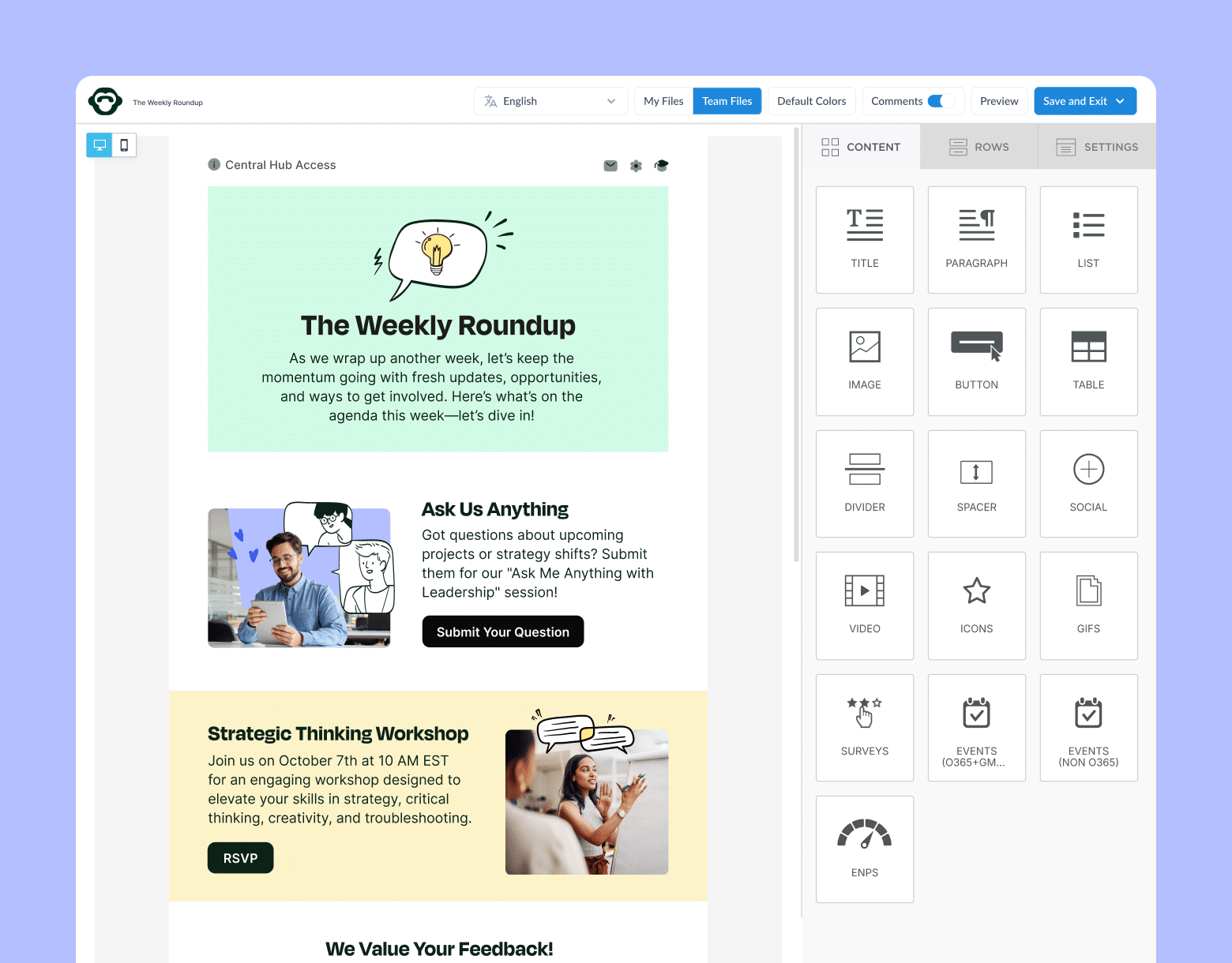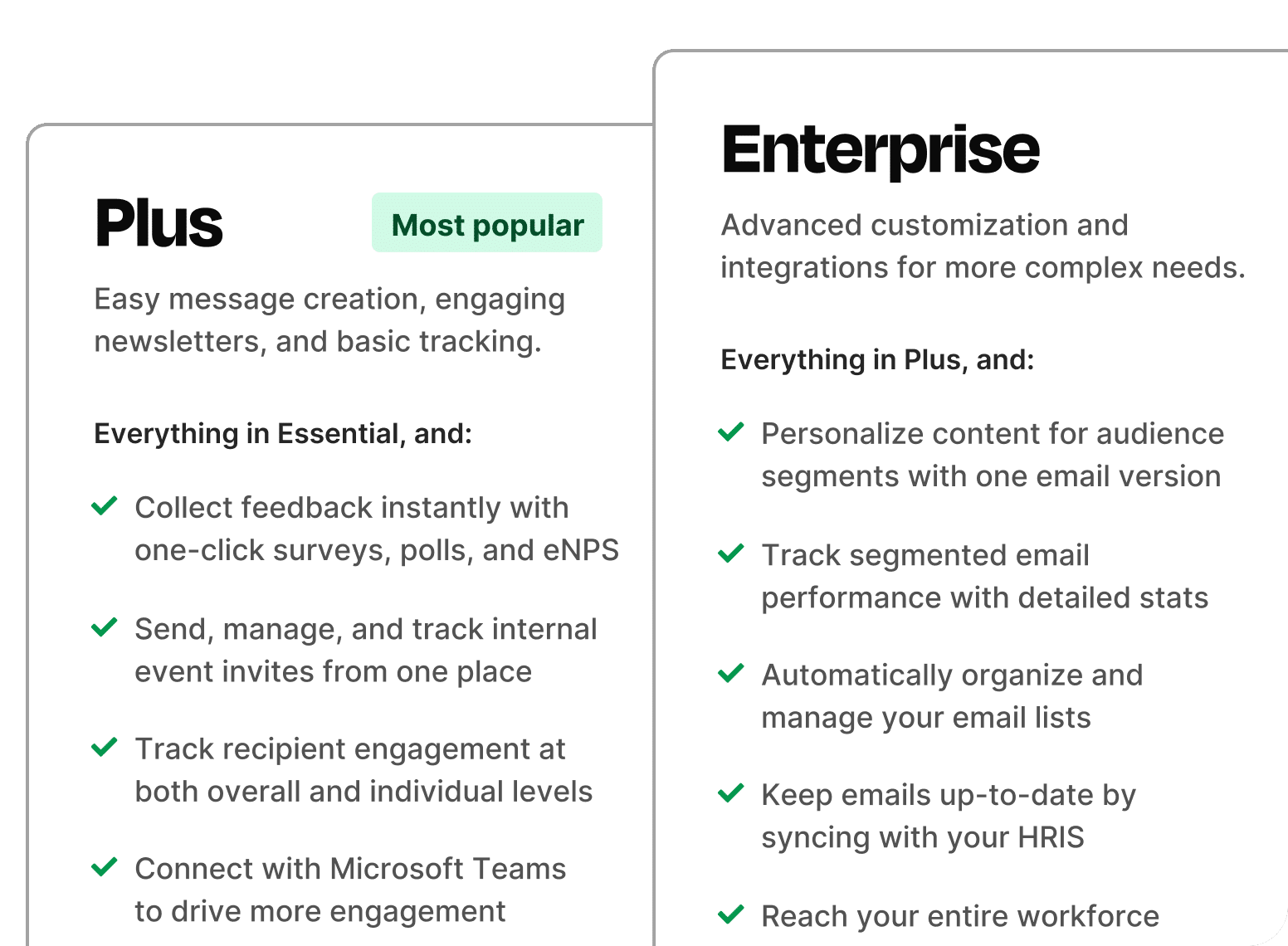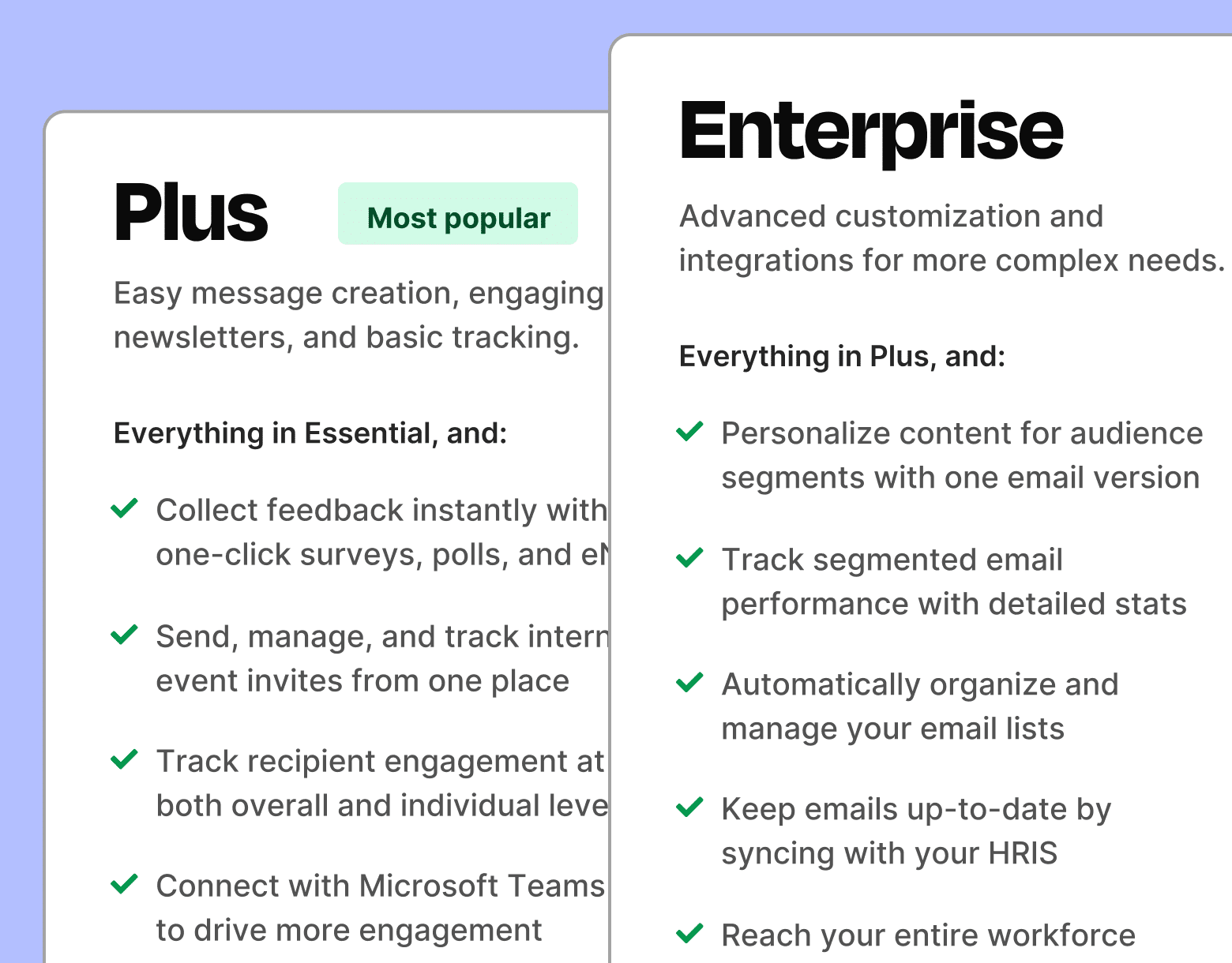As an internal communicator, it’s your job to make organizational changes — large and small — less painful for employees and stakeholders. Read along as we break down change management communication so that you don’t have to overthink it when upheaval comes a-knockin’.
How many times in the last year has your organization had to navigate change? The current climate shows us that many companies have reshaped hybrid or remote work models, been forced to cut costs, and so much more.
We know that workplace change, especially sudden or substantial transformations, can have significant psychological impacts on employees. You may find your teams resistant to change as they feel a loss of control. They may also feel overwhelmed or even lose trust in leadership if change management and communication are not handled with care.
Internal communications are important, and as you read along, we’ll equip you with change management communication best practices and tools for change management that support any organizational change.
Learn how ContactMonkey’s internal communication solutions can help you communicate change.
Take self-guided tour of ContactMonkey
See how our key features can streamline your internal communications.
Take product tour

What is Organizational Change?
Organizational change refers to adjustments in the company’s structure, operations, or strategy. This type of change aims to enhance efficiency, respond to evolving market demands, and resolve internal challenges.
Recognizing the full scope of organizational change will help shape your overall change management and communication strategy.
What is Change Management Communication?
Change management communication is a targeted approach that prepares, informs, and supports employees through various organizational changes. It’s about developing a communication and change management plan that makes change feel manageable, connecting the change and internal communication goals to the broader organizational goals.
Why Effective Communication is Important for Change Management
According to McKinsey & Co., 70% of organizational change efforts fail. Why? Well, successful change initiatives hinge on effective change management and communication.
Here’s why communication matters when managing change:
- Builds trust: Transparent communication fosters trust, showing employees that their leaders care about keeping them informed.
- Minimizes resistance: A strong change management communication plan can mitigate fear or pushback, leading to smoother transitions.
- Aligns with organizational goals: Clear communication ties the change to the company’s vision, helping employees see the bigger picture and how they fit in.
- Boosts engagement: An informed workforce is often more engaged and productive, which is key for any transformation.
Modern internal comms and measurement tools
No design or technical expertise needed. Save time, increase engagement, and dazzle your employees with fun and interactive communications.
Explore all features

Steps to Effective Communication for Change Management
Creating an effective communication and change management plan involves several key steps, each designed to prepare employees, deliver the right messages, and have feedback mechanisms in place. We’ve designed a thorough plan here involving seven steps to help you succeed:
Step 1: Assess the scope of the change
Define the purpose, objectives, and anticipated impact of the change. This foundational understanding shapes the entire change management internal communication strategy.
Key questions to answer:
- What is the change, and why is it needed?
- How will this change affect different teams or departments?
- What are the anticipated challenges or resistance points?
Real-life example: If your company is rolling out a new digital platform, identify who will be using it, how it enhances workflows, and any associated training needs to affirm employees are well-prepared.
🐒 PRO TIP: Get executive buy-in and involvement from the start. When leaders visibly support the change and communicate its importance, employees are more likely to feel secure and engaged. Consider asking leaders to share personal messages about the change’s purpose and their commitment to supporting employees through the transition.
How to leverage ContactMonkey: Use our data insights through the analytics dashboard to better understand the employees and teams impacted by the change. Historical engagement trends can help you anticipate how various groups may respond to the change, allowing you to tailor messaging to resonate with each team’s unique needs and personalities.
Step 2: Identify key stakeholders and change champions
Your change management communication plan will be more effective if it includes change champions—influential employees who support the initiative and can help foster a positive perspective among their peers. Identify stakeholders at every level who will be affected, and make sure they understand and support the change.
Stakeholders to consider:
- Executive leaders: Drive the vision and provide high-level support.
- Managers and supervisors: Act as the primary communicators to their teams.
- Internal communication team: Develops and executes the communication plan.
Real-life example: For an upcoming company restructure, identify leaders in each department who can answer questions, provide support, and guide their teams through the transition.
🐒 PRO TIP: Empower change champions with exclusive updates and provide them with early access to information, FAQs, and resources so they can act as knowledgeable supporters. This way, they’ll feel prepared to handle questions and concerns, giving employees a trusted peer to turn to and helping foster grassroots support.
How to leverage ContactMonkey: Use ContactMonkey’s segmented email lists to keep these change champions informed and prepared with talking points and resources they can share with their teams.
Watch ContactMonkey LIVE in action
Join live demo

Step 3: Develop a clear communication plan
Create a change management communication plan that draws upon internal communication trends, a clear timeline, key messages, and designated communication channels.
Key questions to answer through your plan:
- What information needs to be shared, and in what order?
- What are the main messages that align with the company’s values and vision?
- How often will updates be communicated and through what channels?
Real-life example: If implementing a new project management tool, schedule an initial announcement, a demo session invite, and follow-up emails with FAQs and best practices.
🐒 PRO TIP: Structure your communication messages to cover why the change is happening, what is changing, and how it will impact employees. This approach answers key questions and provides clarity, helping reduce confusion and resistance.
How to leverage ContactMonkey: Use our email templates through the email template builder to craft and schedule each communication, ensuring consistency and branding across all updates.
Step 4: Choose effective communication channels and tools
Your choice of channels and internal communication tools significantly impacts the success of your change management communication strategy.
Effective communication channels and tools to consider:
- Email: For formal announcements that are either company-wide or customized by stakeholder group
- SMS: For urgent communications that need to reach employees ASAP.
- Video messages: Particularly useful for explaining complex changes or for messages from executive leaders. Video adds a personal touch, making it easier for employees to connect with the message.
- Live Q&A sessions or town halls: Events allow employees to ask questions, hear from leaders directly, and reduce ambiguity.
- Surveys and feedback forms: Use change management pulse surveys to gauge employee sentiment and adjust the communication plan if necessary. Pulse surveys can track ongoing perceptions and identify areas that need clarification.
Real-life example: For a shift to a hybrid work model, consider using email for policy updates, video for explaining benefits, and Q&A sessions for direct employee engagement.
🐒 PRO TIP: Reserve email for formal announcements, SMS for urgent updates, video for messages from leadership, and Q&A sessions for interactive engagement. Aligning the message type with the right channel enhances clarity and engagement, making each communication feel relevant and timely.
How to leverage ContactMonkey: Set up email and SMS communication notifications for major updates and integrate pulse surveys into your emails to gauge employee sentiment and gather feedback.
🎁 BONUS: To prove how effective tools can be in increasing engagement, leverage our article on the 10 ways to use technology to increase employee engagement.


Step 5: Deliver consistent and transparent messages
Consistency is essential in any internal communication checklist and change management strategy. Confirm all messaging aligns with the organization’s vision and values, and reinforce the reasons behind the change at every step.
Key points to communicate:
- Current progress and any changes to the timeline.
- Success metrics and anticipated outcomes.
- Any obstacles encountered and adjustments made.
Real-life example: For a company-wide software upgrade, send an organizational announcement, provide weekly progress updates, and clearly define a timeline for completion, addressing any delays openly.
🐒 PRO TIP: Set up a weekly “Change Digest.” This digest keeps employees in the loop, reinforces key messages, and reduces the need for repetitive individual communications.
How to leverage ContactMonkey: Schedule regular update emails using our templates to maintain a steady flow of transparent information and avoid miscommunication in the workplace. Include progress bars or status updates to visually show employees where things stand.
Step 6: Offer training and resources
Change can be overwhelming, especially when it involves new skills or technologies. Providing the right change management training and resources demonstrates that the organization is invested in its employees’ success – a key point to feature through your change management communications plan.
Consider the following training and resources:
- Workshops and training sessions: These can be delivered in person or virtually, depending on employee needs.
- Digital resources: Use email to share guides, FAQs, and videos directly through employee inboxes, ensuring that resources are accessible and easy to reference.
- One-on-one coaching: For particularly complex changes, offering personal coaching sessions can be invaluable.
Real-life example: For a new customer relationship management (CRM) system, organize training sessions, share quick-start guides, and provide access to a centralized resource library.
🐒 PRO TIP: Develop a centralized resource hub with easy-to-access training materials, FAQs, and video guides. Promote this hub in every communication, making it a reliable go-to source for employees throughout the change, reducing confusion and empowering self-service learning.
How to leverage ContactMonkey: Create an email series with links to training resources and include a contact point for further support. Use email tracking to monitor engagement with training materials.
Create internal emails that get opened and read
No design or technical expertise needed. Save time, increase engagement, and dazzle your employees with fun and interactive communications.
Explore email features

Step 7: Monitor feedback and measure success
Tracking and responding to feedback is crucial for an adaptive change management communication strategy.
A few tools and methods to use:
- Employee surveys: Send out surveys at different stages to measure sentiment and get input on how well the communication resonates.
- Engagement metrics: Use ContactMonkey’s analytics to track email open rates, click-throughs, and other engagement metrics to assess message impact.
- Regular check-ins: Encourage managers to have check-ins with their teams to gauge their response and answer any questions.
Real-life example: After a departmental restructure, conduct pulse surveys to understand employee morale and engagement, and adjust communications based on responses.
🐒 PRO TIP: Conduct pre- and post-change surveys. Compare responses to identify sentiment improvements or areas that may need further support, demonstrating your commitment to employee input and continuous improvement.
How to leverage ContactMonkey: Use our analytics to track email open rates, click-throughs, and survey responses. Regularly review these insights to refine future communications and address emerging concerns.
Step 8: Recognize and celebrate milestones
Recognizing and celebrating milestones keeps employees motivated and reinforces the positive aspects of the change. Celebrations show appreciation for the hard work put in during transitions and help build momentum toward full adoption of the change.
Key milestones to celebrate:
- Completion of each phase of the change.
- Achievements by teams or individuals who contributed to the transition.
- Key metrics reached, such as adoption rates or engagement scores.
Real-life Example: After launching a new CRM, celebrate when 80% of users are actively engaging with the platform, and recognize top contributors who helped train their peers.
🐒 PRO TIP: Plan milestone celebrations to acknowledge progress publicly. Use internal communication channels to recognize both big and small wins, which fosters morale and strengthens the change initiative’s success.
How to Leverage ContactMonkey: Use our email templates to send celebratory messages and recognize contributors. Highlight milestones in newsletters or the “Change Digest” mentioned above to keep employees engaged.
Step 9: Build a feedback loop for continuous improvement
A feedback loop allows for ongoing improvements to the communication and change management plan, helping you adjust strategies as the change progresses.
Key areas for feedback:
- Employee satisfaction and engagement with the change.
- Suggestions for improving communication or training resources.
- Insights on challenges or roadblocks that employees face.
Real-life example: After rolling out a flexible work policy, gather feedback on how well the policy supports work-life balance and if additional resources are needed.
🐒 PRO TIP: Establish a designated feedback channel (e.g., an online form or weekly check-in) to collect input from employees. Act on their suggestions quickly to demonstrate responsiveness and boost trust in the process.
How to leverage ContactMonkey: Embed feedback forms directly in emails and use pulse surveys to gauge ongoing sentiment. Regularly review responses to refine your approach based on employee insights.
Step 10: Evaluate and document the success of your change management strategy
Once the change has been implemented, evaluate the overall success of the change management communication strategy. Document key learnings to refine future initiatives and provide a foundation for continuous improvement.
Key areas to evaluate:
- Achievement of desired outcomes and metrics.
- Effectiveness of communication channels and methods.
- Employee engagement and satisfaction levels post-change.
Real-life example: After a major reorganization, assess if productivity, engagement, and team alignment improved as intended. Document learnings to apply to future change management communication plans.
🐒 PRO TIP: Create a post-change report that summarizes outcomes, challenges, and insights gained. Share the report with leadership to showcase the communication team’s role in the change’s success and use the document as a template for future projects.
How to leverage ContactMonkey: Use analytics to evaluate metrics like email engagement, survey responses, and overall participation rates. Include these insights in your post-change report for a data-driven summary.
8 must-have emails to master company changes
Change doesn’t have to be hard. Get our sample emails for free.
Get the template

Best Practices for Change Management Communication Success
To round out your strategy, follow these change management communication best practices for successful implementation:
- Prioritize clarity and brevity: Avoid jargon and keep messages concise.
- Be transparent: Share both successes and setbacks honestly.
- Emphasize and repeat the ‘why’: Help employees understand the purpose of the change and remind them frequently.
- Encourage two-way communication: Create opportunities for employees to share their thoughts.
- Take advantage of tools: Invest in internal communication tools that alleviate your workload (did someone say ChatGPT for internal comms!?) and equip you with analytics.
🎁 BONUS: If you’re running into trouble securing a budget for internal communication tools, check out this guide on how to build a business case for internal communications software.
Benefits of Using ContactMonkey For Change Management Communications
There are a wide-range of benefits of using our internal communications tool to build personalized change management communication strategies, like:
Audience segmentation
Personalized communication: Segment employees by department, role, or location to send relevant, personalized messages about the changes that directly impact them.
Integrated email and SMS channels for timely updates
Multi-channel reach: Combine email and SMS communications for critical updates, ensuring timely delivery across different platforms.
Analytics and engagement tracking
Insightful metrics: Track open rates, click-through rates, and read time to assess employee engagement and refine messaging strategies.
Pulse surveys and feedback forms
Real-time feedback: Gather immediate insights from employees about how they feel regarding the change, allowing for quick adjustments based on sentiment.
Integrations with your existing tools
Seamless workflow integration: Integrates with Outlook, Gmail, and HR systems, allowing you to streamline messaging without disrupting existing workflows.
Ready to learn more about effective change management comms? Book a free demo with one of our experts and see what our tool can do for your organization, no pressure!



